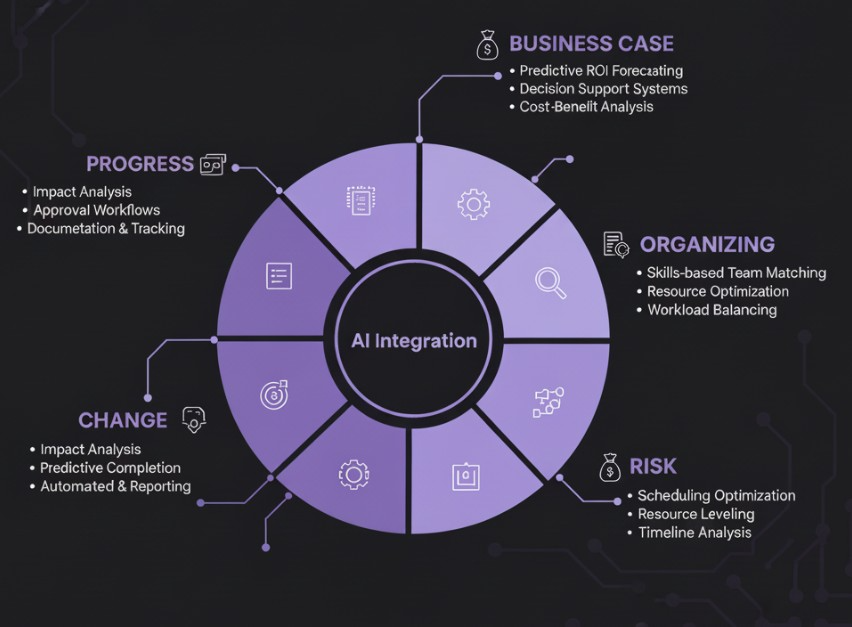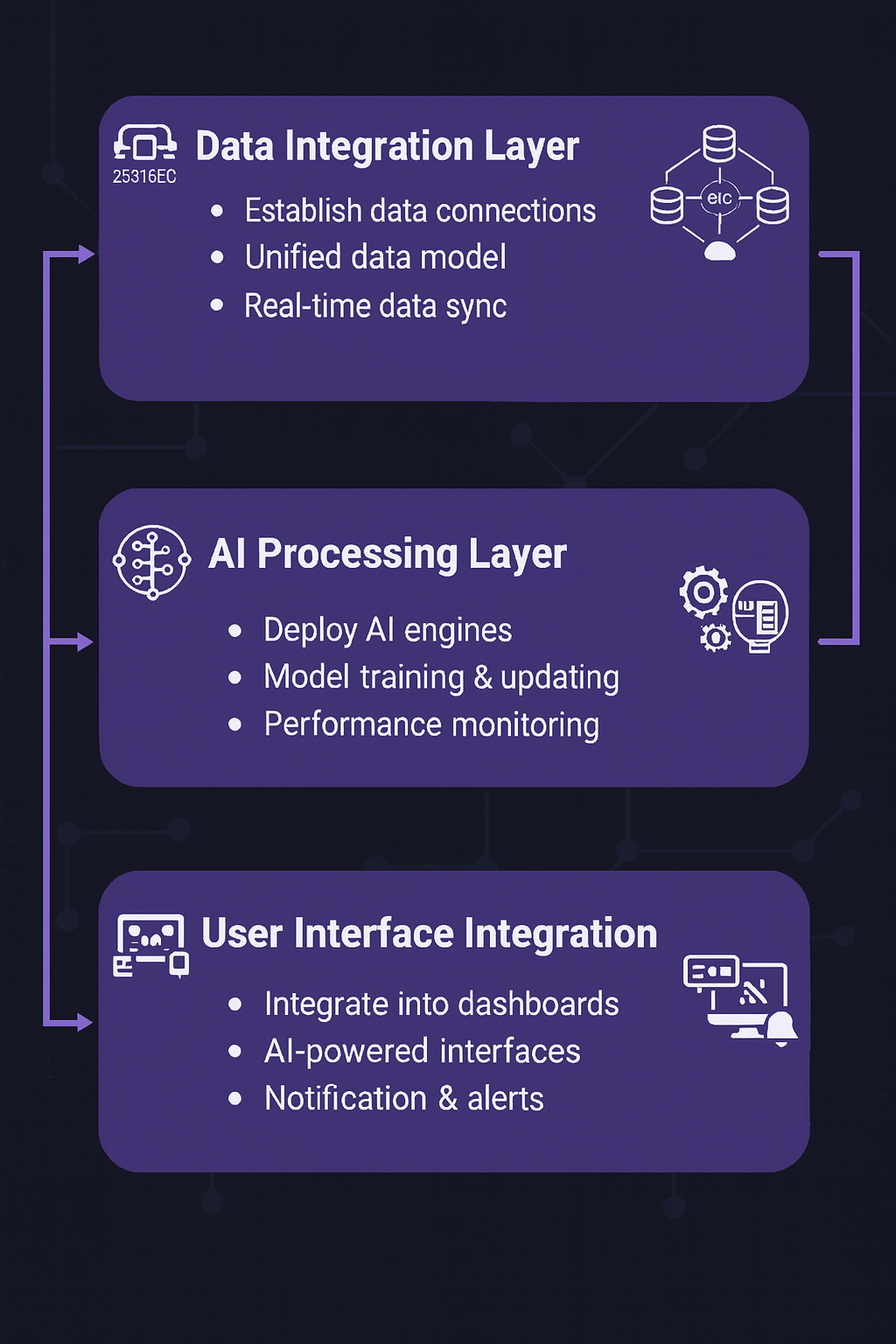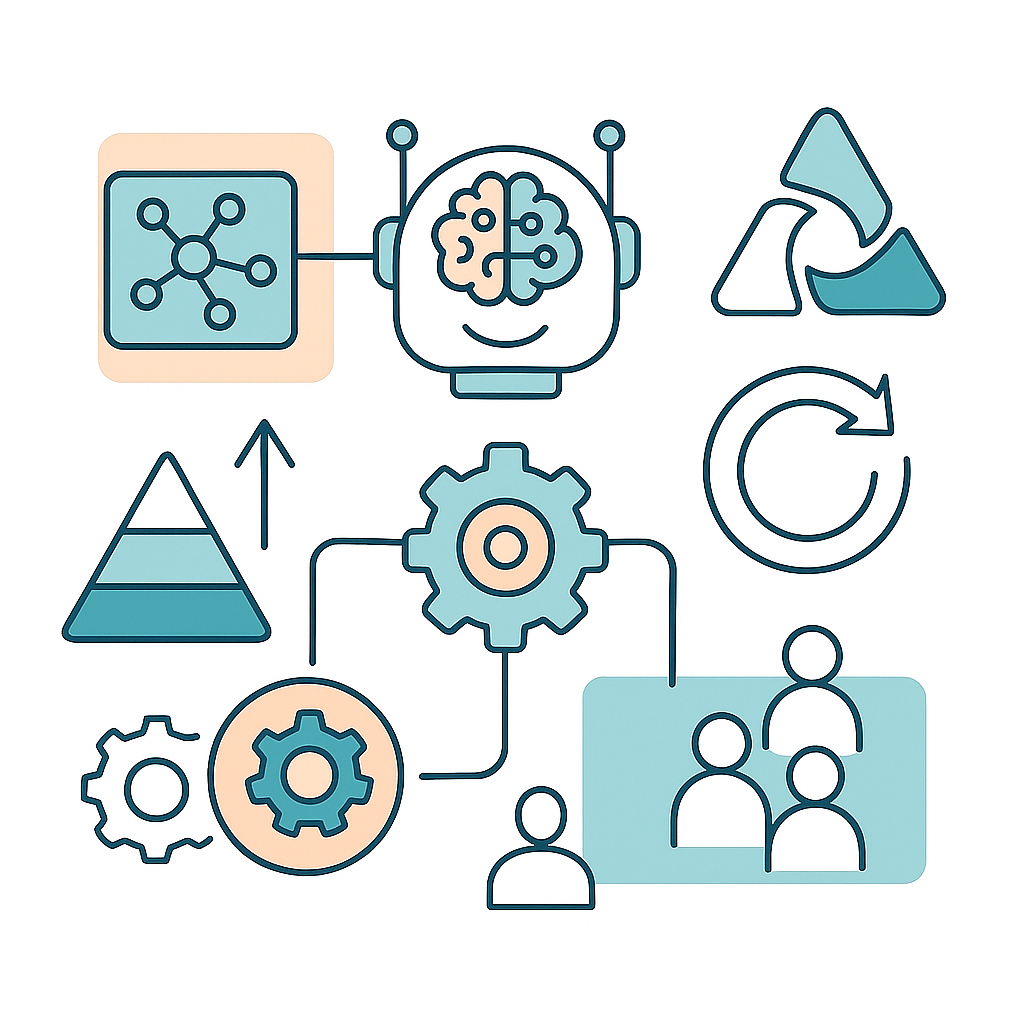Research shows nearly 70% of large projects miss at least one major milestone because decisions are based on stale or incomplete data.
Learning how to integrate AI into the PRINCE2 framework gives project leaders the power to predict risks, optimize resources, and keep delivery on track, turning governance from a burden into a competitive advantage.
In this article, we will:
- Walk through a step-by-step process to integrate AI into PRINCE2
- Show how to combine AI with PRINCE2 agile and scrum for impact
AI PRINCE2 integration: Complete step-by-step process
Integrating artificial intelligence into PRINCE2 methodology transforms traditional project management into a data-driven, predictive powerhouse. This systematic approach ensures seamless AI adoption across all PRINCE2 practices and processes without disrupting your established governance framework.
Let's dive into the four-phase integration process that will revolutionize your project delivery capabilities.
Phase 1: Map AI technologies to PRINCE2 components
Strategic alignment of artificial intelligence capabilities with PRINCE2 practices and processes creates the foundation for successful integration.
Step 1: Identify integration points in PRINCE2 7 practices
The foundation of successful AI integration lies in strategically mapping AI capabilities to each PRINCE2 practice. This ensures comprehensive coverage while maintaining methodology integrity.

Business case practice: Predictive ROI forecasting
- Use machine learning algorithms to analyze historical project data
- Implement decision support systems for investment justification
- Deploy cost-benefit analysis AI tools for ongoing business case validation
Pro tip: Start with historical data from your last 20-30 projects to train predictive models. Projects with similar scope and complexity provide the most accurate forecasting results.
Organizing practice: Intelligent resource allocation
- Use AI algorithms for skills-based team matching
- Implement resource optimization tools for role assignments
- Deploy workload balancing AI across the project hierarchy
Quality practice: Automated quality management
- Implement automated testing and quality assurance tools
- Use NLP for document quality analysis and compliance checking
- Deploy AI monitoring for continuous quality improvement
Plans practice: AI-powered scheduling optimization
- Use AI for intelligent project scheduling and dependency management
- Implement resource leveling algorithms
- Deploy predictive timeline analysis tools
Risk practice: Predictive risk assessment
- Use machine learning for risk pattern recognition
- Implement predictive risk modeling based on historical data
- Deploy real-time risk monitoring and early warning systems
Change practice: Intelligent change impact analysis
- Use AI algorithms to assess change impact across project components
- Implement intelligent change approval workflows
- Deploy automated change documentation and tracking
Progress practice: Real-time AI monitoring
- Use real-time AI analytics for project health monitoring
- Implement predictive completion analysis
- Deploy automated status reporting and exception alerts
Step 2: Map AI tools to PRINCE2 processes
Each PRINCE2 process offers unique opportunities for AI enhancement and automation. The key is selecting tools that integrate seamlessly with your existing workflow.
Starting up a project (SU) + AI integration
- Deploy AI feasibility analysis tools during project mandate review
- Use NLP chatbots for initial stakeholder consultation
- Implement AI-powered project approach recommendation engines
- Specific tools: ChatGPT for document analysis, Microsoft Copilot for project brief creation
Directing a project (DP) + AI integration
- Integrate AI decision support systems for project board meetings
- Use predictive analytics for project authorization decisions
- Deploy automated exception reporting with AI threshold monitoring
- Specific tools: Tableau AI for board reporting, Power BI with AI insights
Initiating a project (IP) + AI integration
- Use AI document generation for project initiation documentation (PID)
- Implement machine learning for initial risk register creation
- Deploy AI team composition and communication strategy tools
- Specific tools: Notion AI for documentation, Wrike Intelligence for planning
Managing product delivery (MP) + AI integration
- Implement AI quality gates for product acceptance
- Use automated testing and validation tools
- Deploy AI-powered resource scheduling and optimization
- Specific tools: Jenkins AI for automated testing, Asana Intelligence for resource management
Pro tip: Always maintain human oversight for critical decisions. AI should augment human judgment, not replace it, especially in stakeholder-sensitive situations.
Phase 2: Technology selection and setup
Choosing the right AI tools and establishing technical architecture for seamless PRINCE2 integration ensures long-term success and scalability.
Step 3: Choose specific AI technologies by category
Selecting the right AI technology depends on your organizational maturity, budget constraints, and integration complexity. Each category serves distinct PRINCE2 enhancement purposes.
Expert systems for PRINCE2 process automation
- Select rule-based AI systems for routine governance tasks
- Configure decision trees for change approval workflows
- Timeline: 2-4 weeks for basic setup, 8-12 weeks for full integration
Natural language processing (NLP) for communication
- Choose NLP tools for document analysis and stakeholder communication
- Integrate chatbots for project status inquiries and document processing
- Timeline: 4-6 weeks for integration and training
Machine learning for predictive analytics
- Select ML platforms for risk prediction and resource optimization
- Train models on historical project data for forecasting
- Timeline: 6-12 weeks for model development and validation
Robotic process automation (RPA) for administrative tasks
- Choose RPA tools for data entry, reporting, and routine documentation
- Automate timesheets, status reports, and compliance documentation
- Timeline: 3-6 weeks per process automation
Step 4: Integration architecture setup
Building a robust integration architecture ensures seamless data flow between PRINCE2 tools and AI systems. This technical foundation determines long-term success.

Data integration layer
- Establish data connections between PRINCE2 tools and AI systems
- Create a unified data model mapping project artifacts to AI inputs
- Implement real-time data synchronization protocols
Specific actions:
- Connect project management tools (MS Project, Smartsheet) to AI platforms
- Set up data warehousing for historical project analysis
- Configure API connections for real-time data flow
AI processing layer
- Deploy AI engines and configure processing workflows
- Establish AI model training and updating procedures
- Implement performance monitoring for the AI system's accuracy
User interface integration
- Integrate AI capabilities into existing PRINCE2 dashboards and tools
- Create AI-powered interfaces for project managers and team members
- Implement notification and alert systems for AI-driven insights
Pro tip: Start with cloud-based solutions like AWS, Azure, or Google Cloud for faster deployment and lower initial infrastructure costs.
Phase 3: Implementation and testing
Controlled pilot deployment to validate AI functionality and measure integration success before full rollout minimizes risks and maximizes learning opportunities.
Step 5: Pilot implementation process
Successful AI integration requires careful pilot testing to validate functionality and user adoption. Choose pilot projects that represent your typical project portfolio complexity.
Select pilot project criteria
- Choose projects with a 6-12 month duration for comprehensive testing
- Select projects with sufficient historical data for AI training
- Ensure project complexity allows testing of multiple PRINCE2 processes
Implement AI in pilot project stages
- Week 1-2: Deploy AI tools for project initiation and planning
- Week 3-8: Integrate AI monitoring and control systems during execution
- Week 9-12: Test AI-powered stage boundary management
- Week 13+: Validate AI integration in project closure processes
Measure and validate AI integration
- Track efficiency improvements in administrative tasks (target: 40-60% reduction)
- Measure accuracy improvements in risk prediction (target: 25-35% better accuracy)
- Monitor user adoption rates and satisfaction scores
Pro tip: Document all pilot outcomes and resistance points to inform your full-scale deployment strategy. Early identification of challenges prevents costly rollback scenarios.
Phase 4: Full-scale implementation
Enterprise-wide deployment with structured change management and continuous optimization for maximum project delivery impact transforms your entire project management capability.
Step 6: Roll-out strategy across PRINCE2 portfolio
Scaling AI integration across your entire project portfolio requires structured change management and continuous optimization based on pilot learnings.
Phased deployment schedule
- Months 1-3: Deploy AI in all new project initiations
- Months 4-6: Integrate AI into ongoing project control processes
- Months 7-9: Implement AI across all project closure activities
- Months 10-12: Optimize and enhance AI capabilities based on usage data
Training and change management
- Conduct role-specific training for project managers, team members, and board members
- Provide hands-on workshops for AI tool usage within the PRINCE2 context
- Establish an AI champions network for peer support and knowledge sharing
Governance and monitoring setup
- Establish an AI governance committee with PRINCE2 methodology expertise
- Create performance metrics and KPIs for AI-enhanced project delivery
- Implement continuous improvement processes for AI system optimization
Pro tip: Create quick-reference guides and video tutorials for common AI-enhanced PRINCE2 tasks. This reduces resistance to change and accelerates user adoption across your organization.
Following this structured approach transforms traditional project management into intelligent, data-driven operations that deliver superior outcomes and competitive advantage.
Hybrid methodology mastery: Combining AI with PRINCE2 agile and scrum for maximum impact
Modern project management demands flexibility without sacrificing control. Hybrid methodologies blend PRINCE2's structured governance with agile's adaptive delivery, while AI amplifies both approaches through intelligent automation and predictive insights.
This integration creates powerful project delivery capabilities that adapt to changing requirements while maintaining strategic alignment.

PRINCE2 agile + AI integration
PRINCE2 agile already bridges structured methodology with flexible delivery. Adding AI creates intelligent project governance that responds to real-time conditions while maintaining board-level oversight.
Core integration elements:
- AI-powered sprint retrospectives that identify improvement patterns
- Automated tolerance monitoring with intelligent exception reporting
- Machine learning algorithms for backlog prioritization based on business value
- Predictive analytics for release planning and milestone forecasting
Implementation approach: Start with AI-enhanced product backlog management using tools like Azure DevOps AI or Jira Intelligence. These platforms automatically analyze user story complexity, predict sprint capacity, and optimize team allocation based on historical velocity data.
Pro tip: Use AI sentiment analysis on retrospective feedback to identify team morale trends before they impact delivery. This early warning system helps project managers address issues proactively.
Scrum-PRINCE2-AI hybrid models
This three-way integration combines Scrum's iterative delivery, PRINCE2's governance framework, and AI's predictive capabilities. The result is adaptive project control that scales from team level to portfolio management.
Hybrid framework components:
- Daily standups enhanced with AI-generated risk alerts and dependency warnings
- Sprint planning powered by machine learning resource optimization
- PRINCE2 stage gates informed by AI-driven completion probability analysis
- Automated progress reporting that satisfies both Scrum transparency and PRINCE2 governance
Success factors: Maintain Scrum's simplicity at the team level while using AI to provide strategic insights to PRINCE2 governance layers. Teams work in familiar sprint cycles, but leadership receives intelligent dashboards showing predictive project health metrics.
DevOps integration strategies
AI-enhanced PRINCE2 methodologies integrate seamlessly with DevOps practices through intelligent automation pipelines and continuous feedback loops.
Key integration points:
- Automated testing triggered by PRINCE2 quality gates
- AI-powered deployment decisions based on project risk tolerances
- Continuous integration with PRINCE2 change control workflows
- Machine learning models that predict deployment success rates
Continuous delivery with AI enhancement transforms traditional project phases into dynamic, responsive delivery cycles. AI monitors code quality, user feedback, and system performance to recommend optimal release timing within PRINCE2 governance constraints.
Sprint planning with AI insights
Traditional sprint planning relies on team estimation and historical velocity. AI-enhanced sprint planning adds predictive analytics, resource optimization, and risk assessment to improve planning accuracy.
AI planning capabilities:
- Automated story point estimation based on historical data patterns
- Team capacity prediction considering individual skill sets and availability
- Risk-adjusted sprint commitment recommendations
- Dependency analysis with automated conflict resolution suggestions
Implementation strategy: Deploy AI planning assistants that integrate with existing tools like Monday.com AI or ClickUp Brain. These platforms analyze your team's historical performance, current workload, and project constraints to suggest optimal sprint compositions.
Pro tip: Use AI to identify sprint planning patterns that consistently lead to successful delivery. Teams can replicate successful planning approaches while avoiding configurations that historically cause problems.
Modern organizations thrive when they combine structured governance, adaptive delivery, and intelligent automation. This hybrid approach delivers the control needed for strategic alignment with the flexibility required for competitive advantage.
Turn rigid governance into a predictive control system
Rigid PRINCE2 governance can evolve into a predictive control system when enhanced with AI. Instead of relying on static reports and delayed decision-making, project boards gain real-time insights that anticipate risks and highlight opportunities.
By piloting first and scaling with care, organizations keep the discipline of PRINCE2 while adding the agility and intelligence needed to deliver faster, smarter, and with greater confidence.


%20(1).jpg)
_light%201.png)





